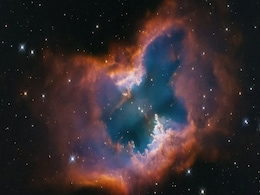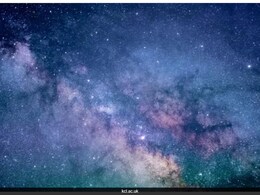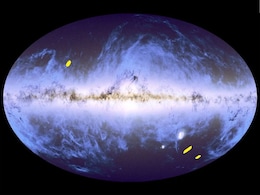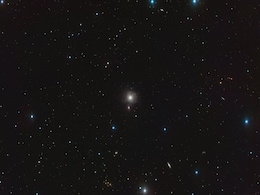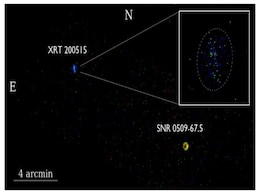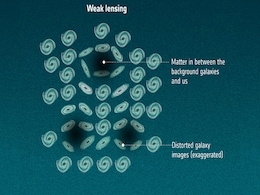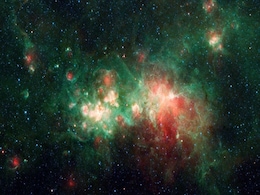Cosmic Observations
- All
- News
-

Hubble Captures Mars, Cosmic Nebulae, and Distant Galaxies in Spectacular 35th Anniversary Photos
- Saturday April 26, 2025
- Written by Gadgets 360 Staff
To celebrate 35 years in orbit, the Hubble Space Telescope has released breathtaking new images of Mars, a planetary nebula, and a distant spiral galaxy. Since its 1990 launch, Hubble has captured nearly 1.7 million observations and continues to awe scientists and stargazers alike with vivid cosmic scenes that reveal the ever-changing beauty of our...
-
 www.gadgets360.com
www.gadgets360.com
-

Twinkling Star Reveals Hidden Plasma Structure Near Earth
- Tuesday April 22, 2025
- Science | Daniel Reardon, The Conversation
With the most powerful radio telescope in the southern hemisphere, we have observed a twinkling star and discovered an abundance of mysterious plasma structures in our cosmic neighbourhood.
-
 www.ndtv.com
www.ndtv.com
-

Did Black Hole Radiation Shape the Universe?
- Saturday March 29, 2025
- Written by Gadgets 360 Staff
A study suggests that Hawking radiation, first proposed by Stephen Hawking, may have influenced the universe’s structure. According to reports, primordial black holes that existed in the early universe could have evaporated through Hawking radiation, impacting matter distribution. The research explores how these black holes might have shaped gala...
-
 www.gadgets360.com
www.gadgets360.com
-

ESA’s Euclid Telescope Releases First Data, Mapping 26 Million Galaxies
- Wednesday March 26, 2025
- Written by Gadgets 360 Staff
ESA’s Euclid telescope has released its first dataset, mapping 26 million galaxies within a week. The observations include deep-field images, a survey of 380,000 galaxies, and 500 new gravitational lens candidates. Scientists will continue tracking cosmic evolution over six years. The dataset, currently 35 terabytes, is expected to grow to 2 peta...
-
 www.gadgets360.com
www.gadgets360.com
-

Smallest Galaxy Ever Found: Andromeda XXXV Defies Cosmic Evolution Models
- Thursday March 13, 2025
- Written by Gadgets 360 Staff
Astronomers have discovered Andromeda XXXV, the smallest and faintest known galaxy, located 3 million light-years away. It challenges existing models of galaxy formation, as similar small galaxies were thought to be destroyed in the early universe. Researchers are studying how it retained conditions for star formation despite harsh cosmic environme...
-
 www.gadgets360.com
www.gadgets360.com
-

Black Hole Singularities May Not Exist, Say Scientists
- Friday March 7, 2025
- Written by Gadgets 360 Staff
A new study questions the existence of black hole singularities, suggesting refinements to Einstein’s equations using quantum gravity concepts. Researchers argue that infinite density points may not be real, replacing them with highly curved but finite regions of space-time. While direct observation remains difficult, gravitational waves and earl...
-
 www.gadgets360.com
www.gadgets360.com
-

NASA’s SPHEREx Telescope Launching Aboard SpaceX Falcon 9 to Explore Cosmic Evolution
- Friday February 28, 2025
- Written by Gadgets 360 Staff
NASA’s SPHEREx telescope, launching on Feb 28 aboard a SpaceX Falcon 9, will map the entire sky in infrared, observing 450 million galaxies and 100 million Milky Way stars. The mission aims to uncover the large-scale structure of the universe, track icy molecules in interstellar space, and study cosmic inflation. Equipped with a spectrophotometer...
-
 www.gadgets360.com
www.gadgets360.com
-

NASA Supercomputer Finds Spiral Structure in the Oort Cloud’s Inner Region
- Thursday February 27, 2025
- Written by Gadgets 360 Staff
A NASA supercomputer model suggests that the Oort Cloud’s inner structure forms a spiral, influenced by galactic tides. The Oort Cloud, a distant icy shell surrounding the solar system, has remained unobservable due to its vast distance. Researchers believe this finding could redefine understanding of how comets originate and interact with cosmic...
-
 www.gadgets360.com
www.gadgets360.com
-

Astronomers Spot Galaxy NGC 3640 With a Past of Consuming Smaller Galaxies
- Tuesday February 25, 2025
- Written by Gadgets 360 Staff
Recent observations of NGC 3640 reveal a history of merging with smaller galaxies. Located 88 million light-years away, the elliptical galaxy is suspected to be on a collision course with NGC 3641. The Very Large Telescope captured structural distortions, hinting at previous mergers. Researchers have identified ancient stars acting as fossil marker...
-
 www.gadgets360.com
www.gadgets360.com
-

Unusual X-ray Flash in Large Magellanic Cloud Puzzles Astronomers
- Tuesday February 25, 2025
- Written by Gadgets 360 Staff
A brief yet intense X-ray flash, XRT 200515, was detected in NASA's Chandra telescope data from 2000. The signal, originating from the Large Magellanic Cloud, has left scientists debating its cause. Possible explanations include a neutron star pulling in gas from a companion star or a powerful flare from a distant magnetar. Researchers also specula...
-
 www.gadgets360.com
www.gadgets360.com
-

Weak Gravitational Lensing Examines Universe’s Structure: What You Need to Know
- Thursday February 13, 2025
- Written by Gadgets 360 Staff
The universe's large-scale uniformity is under scrutiny through weak gravitational lensing. Researchers are analysing data from the Euclid Space Telescope to detect potential anisotropies in cosmic expansion. If confirmed, these findings could challenge the fundamental Cosmological Principle, which assumes the universe has no preferred direction. T...
-
 www.gadgets360.com
www.gadgets360.com
-

Hubble Spots Distant Supernova in Gemini, Enhancing Cosmic Distance Studies
- Tuesday February 4, 2025
- Written by Gadgets 360 Staff
The NASA/ESA Hubble Space Telescope has captured a stunning image of SN 2022aajn, a Type Ia supernova in the constellation Gemini. Located 600 million light-years away, the explosion was first detected in November 2022. Type Ia supernovae serve as essential cosmic distance markers due to their predictable brightness. Hubble’s observations, part o...
-
 www.gadgets360.com
www.gadgets360.com
-

JWST Detects Unexpectedly Massive Black Holes in the Early Universe
- Monday February 3, 2025
- Written by Gadgets 360 Staff
A new study led by Jorryt Matthee of ISTA reveals that black holes in early galaxies were significantly more massive than expected. Using JWST data, researchers found that some black holes accounted for nearly 10% of their galaxy's stellar mass—far exceeding the 0.01% ratio seen in modern galaxies. The findings challenge existing growth models, s...
-
 www.gadgets360.com
www.gadgets360.com
-

New Cosmic Surveys Reveal Unexpected Clues About Universe’s Evolution
- Monday February 3, 2025
- Written by Gadgets 360 Staff
A new study published in the Journal of Cosmology and Astroparticle Physics reveals a potential discrepancy in the expected clumpiness of cosmic structures. Researchers from the University of Pennsylvania and Lawrence Berkeley National Laboratory analysed data from the Atacama Cosmology Telescope (ACT) and the Dark Energy Spectroscopic Instrument (...
-
 www.gadgets360.com
www.gadgets360.com
-

Vera C. Rubin Observatory to Detect Millions of Exploding Stars
- Wednesday January 29, 2025
- Written by Gadgets 360 Staff
The Vera C. Rubin Observatory, set to begin its 10-year Legacy Survey of Space and Time (LSST) later this year, will track millions of Type Ia supernovae to advance our understanding of dark energy. These supernovae, resulting from white dwarf stars in binary systems, will be studied in detail to provide crucial data on the universe’s acceleratin...
-
 www.gadgets360.com
www.gadgets360.com
-

Hubble Captures Mars, Cosmic Nebulae, and Distant Galaxies in Spectacular 35th Anniversary Photos
- Saturday April 26, 2025
- Written by Gadgets 360 Staff
To celebrate 35 years in orbit, the Hubble Space Telescope has released breathtaking new images of Mars, a planetary nebula, and a distant spiral galaxy. Since its 1990 launch, Hubble has captured nearly 1.7 million observations and continues to awe scientists and stargazers alike with vivid cosmic scenes that reveal the ever-changing beauty of our...
-
 www.gadgets360.com
www.gadgets360.com
-

Twinkling Star Reveals Hidden Plasma Structure Near Earth
- Tuesday April 22, 2025
- Science | Daniel Reardon, The Conversation
With the most powerful radio telescope in the southern hemisphere, we have observed a twinkling star and discovered an abundance of mysterious plasma structures in our cosmic neighbourhood.
-
 www.ndtv.com
www.ndtv.com
-

Did Black Hole Radiation Shape the Universe?
- Saturday March 29, 2025
- Written by Gadgets 360 Staff
A study suggests that Hawking radiation, first proposed by Stephen Hawking, may have influenced the universe’s structure. According to reports, primordial black holes that existed in the early universe could have evaporated through Hawking radiation, impacting matter distribution. The research explores how these black holes might have shaped gala...
-
 www.gadgets360.com
www.gadgets360.com
-

ESA’s Euclid Telescope Releases First Data, Mapping 26 Million Galaxies
- Wednesday March 26, 2025
- Written by Gadgets 360 Staff
ESA’s Euclid telescope has released its first dataset, mapping 26 million galaxies within a week. The observations include deep-field images, a survey of 380,000 galaxies, and 500 new gravitational lens candidates. Scientists will continue tracking cosmic evolution over six years. The dataset, currently 35 terabytes, is expected to grow to 2 peta...
-
 www.gadgets360.com
www.gadgets360.com
-

Smallest Galaxy Ever Found: Andromeda XXXV Defies Cosmic Evolution Models
- Thursday March 13, 2025
- Written by Gadgets 360 Staff
Astronomers have discovered Andromeda XXXV, the smallest and faintest known galaxy, located 3 million light-years away. It challenges existing models of galaxy formation, as similar small galaxies were thought to be destroyed in the early universe. Researchers are studying how it retained conditions for star formation despite harsh cosmic environme...
-
 www.gadgets360.com
www.gadgets360.com
-

Black Hole Singularities May Not Exist, Say Scientists
- Friday March 7, 2025
- Written by Gadgets 360 Staff
A new study questions the existence of black hole singularities, suggesting refinements to Einstein’s equations using quantum gravity concepts. Researchers argue that infinite density points may not be real, replacing them with highly curved but finite regions of space-time. While direct observation remains difficult, gravitational waves and earl...
-
 www.gadgets360.com
www.gadgets360.com
-

NASA’s SPHEREx Telescope Launching Aboard SpaceX Falcon 9 to Explore Cosmic Evolution
- Friday February 28, 2025
- Written by Gadgets 360 Staff
NASA’s SPHEREx telescope, launching on Feb 28 aboard a SpaceX Falcon 9, will map the entire sky in infrared, observing 450 million galaxies and 100 million Milky Way stars. The mission aims to uncover the large-scale structure of the universe, track icy molecules in interstellar space, and study cosmic inflation. Equipped with a spectrophotometer...
-
 www.gadgets360.com
www.gadgets360.com
-

NASA Supercomputer Finds Spiral Structure in the Oort Cloud’s Inner Region
- Thursday February 27, 2025
- Written by Gadgets 360 Staff
A NASA supercomputer model suggests that the Oort Cloud’s inner structure forms a spiral, influenced by galactic tides. The Oort Cloud, a distant icy shell surrounding the solar system, has remained unobservable due to its vast distance. Researchers believe this finding could redefine understanding of how comets originate and interact with cosmic...
-
 www.gadgets360.com
www.gadgets360.com
-

Astronomers Spot Galaxy NGC 3640 With a Past of Consuming Smaller Galaxies
- Tuesday February 25, 2025
- Written by Gadgets 360 Staff
Recent observations of NGC 3640 reveal a history of merging with smaller galaxies. Located 88 million light-years away, the elliptical galaxy is suspected to be on a collision course with NGC 3641. The Very Large Telescope captured structural distortions, hinting at previous mergers. Researchers have identified ancient stars acting as fossil marker...
-
 www.gadgets360.com
www.gadgets360.com
-

Unusual X-ray Flash in Large Magellanic Cloud Puzzles Astronomers
- Tuesday February 25, 2025
- Written by Gadgets 360 Staff
A brief yet intense X-ray flash, XRT 200515, was detected in NASA's Chandra telescope data from 2000. The signal, originating from the Large Magellanic Cloud, has left scientists debating its cause. Possible explanations include a neutron star pulling in gas from a companion star or a powerful flare from a distant magnetar. Researchers also specula...
-
 www.gadgets360.com
www.gadgets360.com
-

Weak Gravitational Lensing Examines Universe’s Structure: What You Need to Know
- Thursday February 13, 2025
- Written by Gadgets 360 Staff
The universe's large-scale uniformity is under scrutiny through weak gravitational lensing. Researchers are analysing data from the Euclid Space Telescope to detect potential anisotropies in cosmic expansion. If confirmed, these findings could challenge the fundamental Cosmological Principle, which assumes the universe has no preferred direction. T...
-
 www.gadgets360.com
www.gadgets360.com
-

Hubble Spots Distant Supernova in Gemini, Enhancing Cosmic Distance Studies
- Tuesday February 4, 2025
- Written by Gadgets 360 Staff
The NASA/ESA Hubble Space Telescope has captured a stunning image of SN 2022aajn, a Type Ia supernova in the constellation Gemini. Located 600 million light-years away, the explosion was first detected in November 2022. Type Ia supernovae serve as essential cosmic distance markers due to their predictable brightness. Hubble’s observations, part o...
-
 www.gadgets360.com
www.gadgets360.com
-

JWST Detects Unexpectedly Massive Black Holes in the Early Universe
- Monday February 3, 2025
- Written by Gadgets 360 Staff
A new study led by Jorryt Matthee of ISTA reveals that black holes in early galaxies were significantly more massive than expected. Using JWST data, researchers found that some black holes accounted for nearly 10% of their galaxy's stellar mass—far exceeding the 0.01% ratio seen in modern galaxies. The findings challenge existing growth models, s...
-
 www.gadgets360.com
www.gadgets360.com
-

New Cosmic Surveys Reveal Unexpected Clues About Universe’s Evolution
- Monday February 3, 2025
- Written by Gadgets 360 Staff
A new study published in the Journal of Cosmology and Astroparticle Physics reveals a potential discrepancy in the expected clumpiness of cosmic structures. Researchers from the University of Pennsylvania and Lawrence Berkeley National Laboratory analysed data from the Atacama Cosmology Telescope (ACT) and the Dark Energy Spectroscopic Instrument (...
-
 www.gadgets360.com
www.gadgets360.com
-

Vera C. Rubin Observatory to Detect Millions of Exploding Stars
- Wednesday January 29, 2025
- Written by Gadgets 360 Staff
The Vera C. Rubin Observatory, set to begin its 10-year Legacy Survey of Space and Time (LSST) later this year, will track millions of Type Ia supernovae to advance our understanding of dark energy. These supernovae, resulting from white dwarf stars in binary systems, will be studied in detail to provide crucial data on the universe’s acceleratin...
-
 www.gadgets360.com
www.gadgets360.com

